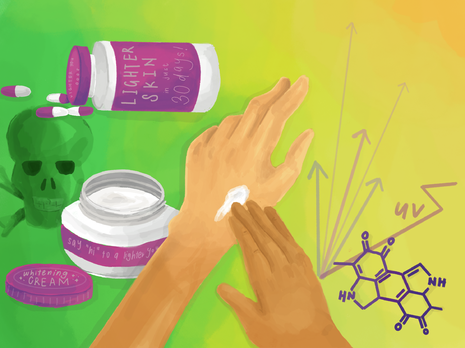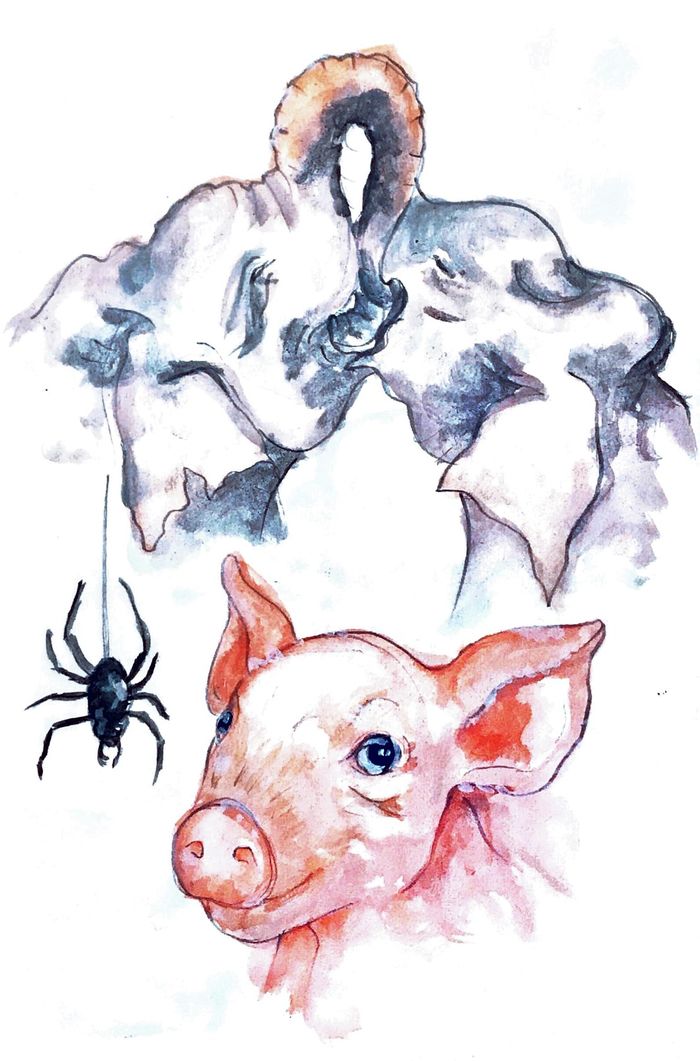Why melanin matters, and the dangers of the skin lightening industry
Sambhavi Sneha Kumar explains the evolutionary purpose of melanin production in the skin, and discusses why treatments to lighten the skin can have serious long term effects

Content Note: This article contains discussion of colourism.
As we experience the tentative grey skies of a typical British summer with the odd welcome ‘heatwave’, it is understandable that when the sun does peek out from behind the clouds many will flock outdoors — some coated with sunscreen but others less bothered. Unsurprisingly, as revealed by the Global Solar Atlas, the United Kingdom on average receives a rather low intensity of sunlight. While this isn’t so good for our beach ‘staycations’, it does mean that we are exposed to a relatively low amount of ultraviolet radiation. The link between ultraviolet radiation and cancers of the skin is well known: essentially, ultraviolet radiation can act as a carcinogen by causing DNA mutations and genetic damage in skin cells. There is a lot we can do to artificially protect our skin — think hats and sunscreen — but the human body has evolved its own defence mechanisms.
The term ‘melanin’ refers to a group of natural pigments produced by most organisms. It is not limited to the skin; a melanin variant is also responsible for the colour of red hair, and another is found in the brain that may even be effective in treating the neurodegenerative disease Alzheimer’s. In the skin, exposure to ultraviolet radiation triggers the production of melanin, which causes skin darkening. Skin melanin can be capable of dissipating over 99.9% of absorbed UV radiation. This idea fits in with the observation that melanin production in the human skin saw a notable increase around 1.2 million years ago, when humans started to lose the body hair that would have previously protected them from UV radiation. Indeed, most hairy or furry mammals still have lighter skin under their protective hair or fur.
“The societal dangers of perpetuating the idea that a certain skin tone is ‘more attractive’ are hugely concerning”
Melanin seems to be just one more clever adaptation of the human body to protect ourselves from our environment. So why is there such huge demand for skin lightening products? In the West, it is more common to find tanning products lining shop shelves — the global self-tanning industry was estimated to be worth 1.47 billion US dollars in 2018. However, the demand for skin lightening products may surprise some: the global market is expected to be worth nearly 9 billion US dollars within the next 10 years. Estimates for the proportion of the population using these products vary wildly; for women in some regions, such as in parts of Asia, it may be as high as 25-67%. There are a range of factors at play here, from different beauty standards in different cultures to people’s desire to get rid of awkward tan lines, but it is the former that is arguably responsible for the majority of the money to be made in skin lightening. Of course, the societal dangers of perpetuating the idea that a certain skin tone is ‘more attractive’ are hugely concerning, but skin lightening products and services can also be dangerous to health on an individual level. The longer a product is used for, the greater the likelihood that significant long term damage will occur. This is why it is especially dangerous to favour lighter skin tones in front of younger individuals, a risk that is worsening with the increased use of social media in young people. If they go on to use skin lightening products for many years, their skin health could be at major risk.
Most skin lightening products are applied topically, which means applying them directly to the skin. Contact dermatitis is a risk for the majority, causing inflammation of the skin, but there are many other ways skin lightening products can cause harm. Hydroquinone is a classic example of an agent that has been used for years to treat disorders of hyperpigmentation, but when used inappropriately for skin lightening, it has been associated with abnormal pigmentation (such as of a blue colour) and squamous cell carcinoma. Some skin lightening products even contain mercury, which can be severely toxic if ingested and corrosive to the skin if applied. Mercury salts inhibit melanin formation and thus can prevent skin tanning but, of course, this can also be hugely dangerous. Whilst the Minamata Convention on Mercury has established an upper limit of 1 milligram per kilogram of mercury in skin lightening products, this requirement is all too often surpassed. Policing the safety of skin lightening products is becoming increasingly difficult, and it is the customer that ends up putting their skin at risk.
“Changing appearance does offer a way for us to express our personalities and individuality, but often it can unmask deeper prejudices in society and personal insecurities.”
Changing appearance does offer a way for us to express our personalities and individuality, but often it can unmask deeper prejudices in society and personal insecurities. Indeed, worrying over skin colour can worsen individuals’ mental health, and equally, those struggling with self-confidence may be more predisposed to undergoing skin-lightening treatments which could worsen their physical health. Of course, avoiding excessive sunlight exposure and skin protection are both arguably wise decisions, but trying to reverse the body’s natural, physiological response (melanin production) is dangerous for both individuals and for society at large.
 Comment / Plastic pubs: the problem with Cambridge alehouses 5 January 2026
Comment / Plastic pubs: the problem with Cambridge alehouses 5 January 2026 News / New movement ‘Cambridge is Chopped’ launched to fight against hate crime7 January 2026
News / New movement ‘Cambridge is Chopped’ launched to fight against hate crime7 January 2026 News / Uni-linked firms rank among Cambridgeshire’s largest7 January 2026
News / Uni-linked firms rank among Cambridgeshire’s largest7 January 2026 News / SU stops offering student discounts8 January 2026
News / SU stops offering student discounts8 January 2026 News / Cambridge businesses concerned infrastructure delays will hurt growth5 January 2026
News / Cambridge businesses concerned infrastructure delays will hurt growth5 January 2026









